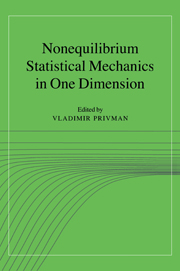Book contents
- Frontmatter
- Contents
- Contributors
- Preface
- Part I Reaction-Diffusion Systems and Models of Catalysis
- Part II Kinetic Ising Models
- Part III Ordering, Coagulation, Phase Separation
- 7 Phase-ordering dynamics in one dimension
- 8 Phase separation, cluster growth, and reaction kinetics in models with synchronous dynamics
- 9 Stochastic models of aggregation with injection
- Part IV Random Adsorption and Relaxation Processes
- Part V Fluctuations in Particle and Surface Systems
- Part VI Diffusion and Transport in One Dimension
- Part VII Experimental Results
- Index
- Abbreviations
8 - Phase separation, cluster growth, and reaction kinetics in models with synchronous dynamics
Published online by Cambridge University Press: 18 December 2009
- Frontmatter
- Contents
- Contributors
- Preface
- Part I Reaction-Diffusion Systems and Models of Catalysis
- Part II Kinetic Ising Models
- Part III Ordering, Coagulation, Phase Separation
- 7 Phase-ordering dynamics in one dimension
- 8 Phase separation, cluster growth, and reaction kinetics in models with synchronous dynamics
- 9 Stochastic models of aggregation with injection
- Part IV Random Adsorption and Relaxation Processes
- Part V Fluctuations in Particle and Surface Systems
- Part VI Diffusion and Transport in One Dimension
- Part VII Experimental Results
- Index
- Abbreviations
Summary
An exact solution of a lattice spin model of ordering in one dimension is reviewed in this chapter. The model dynamics is synchronous, cellularautomaton- like, and involves interface diffusion and pairwise annihilation as well as spin flips due to an external field that favors one of the phases. At phase coexistence, structure-factor scaling applies, and the scaling function is obtained exactly. For field-driven, off-coexistence ordering, the scaling description breaks down for large enough times. The order parameter and the spin-spin correlation function are derived analytically, and several temporal and spatial scales associated with them analyzed.
Introduction
Phase separation, nucleation, ordering, and cluster growth are interrelated topics of great practical importance. One-dimensional (1D) phase separation, for which exact results can be derived, is discussed in this chapter. The emphasis will be on dynamical rules that involve simultaneous updating of the 1D-lattice ‘spin’ variables. Such models allow a particularly transparent formulation in terms of equations of motion the linearity of which yields exact solvability.
The results are also related to certain reaction-diffusion models of annihilating particles (see Part I of this book), and to deposition-with-relaxation processes (Part IV). Some of these connections will be reviewed here as well. While certain reaction and deposition processes have experimental realizations in 1D (see Part VII), 1D models of nucleation and cluster growth have been explored mainly as test cases for modern scaling theories of, for instance, structure-factor scaling, which will be reviewed in detail.
- Type
- Chapter
- Information
- Nonequilibrium Statistical Mechanics in One Dimension , pp. 167 - 180Publisher: Cambridge University PressPrint publication year: 1997



